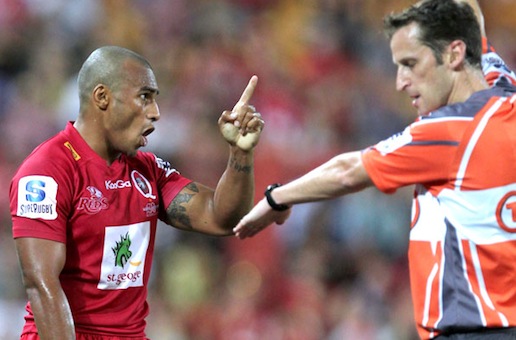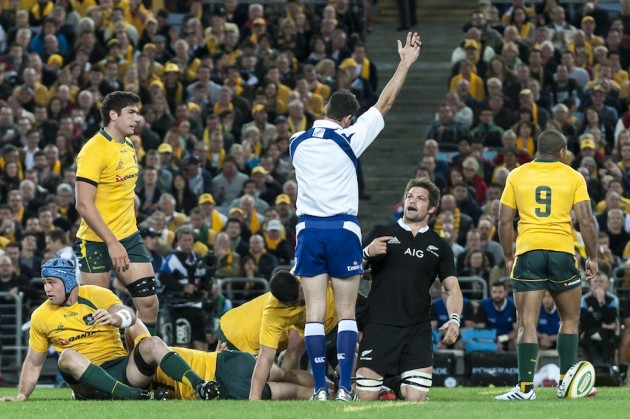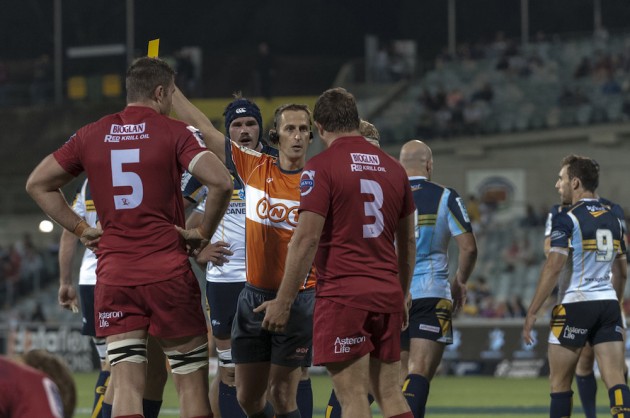A very leading referee told me recently that in recent years the IRB had moved away from law “interpretation”. A few years back the mantra from on high was ‘let the game flow’. But that had changed. Now, he insisted, the IRB directive was to promote black letter law in place of interpretation itself: applying the laws strictly and letting teams adapt their games accordingly.
I believe that the idea that interpretation is out is largely a specious, if not fictitious point. The black letter law approach is an effort to take referees’ own understandings of how the game should be played – their “feel” for the game, which varies from rugby culture to rugby culture – out of the equation.
However, rugby law consist of two parts: the legislation – the Laws as written – and the common law – the set of unwritten conventions as to how certain laws will be applied in given situations. How the common law is shaped is an ongoing process. Referees often give indications at the start of every season as to what will be emphasised this year and in the early rounds the content of these emphases becomes apparent. Coaches develop strategies that push the laws and referees duly respond – much as cases come before judges who then define previous rules with increasing specificity.
How the common law is interpreted, that is, what broad principles this ongoing process is interpreted with reference to, matters a great deal to what we see on the pitch. It is inevitable, regardless of what the IRB might think.
But what principles should guide this process? Personally, I’d like to see the foundation of our common law as being to encourage rugby that rewards skills. “Skills”, of course, should not be taken to include only passing and running, where Australian players are often strong, but also contact, ruck effectiveness, and scrummaging.
What would this mean in practice? I would identify a few clear areas where I’d like to see referees apply the law differently in line with this base principle, all requiring more stringent action against negative rugby – play that seeks to close down space and time and is in breach of the written law.
Obstruction
In the last two years, referees have become much more strict on penalising obstruction off the ball. For instance, it is now commonplace to see teams receiving kickoffs penalised for protecting their jumpers. In line with promoting skills (obstruction is not a skill), I’d like to see this taken much further. How was Colin Slade’s try against the Blues not clear obstruction against Jackson Willison? For that matter, what about Owen Farrell’s at Twickenham?
How often are box kicks protected by forwards not part of the ruck and materially preventing the opposition from getting to the scrum half? How often do we still see mauls illegally set up, where the defence never has a chance to take down the man with the ball (the disallowing of the Brumbies’ try against the Force was an excellent and courageous decision)? Obstruction is a blight on the game and it should be removed.
Rolling Away
Referees tend to be very strict on tackling players rolling away from the ball, as Wales’ scrum-half Rhys Webb found after delivering a crunching hit against England on Saturday. However, referees are very lenient about players being rucked over and then standing up or otherwise impeding the opposition 9 from clearing the ball, or requiring an extra forward to clear them out.
This is a New Zealand special; I wrote at length about this particular phenomenon after the Bledisloe Cup last year. It is also clearly against the law, which requires players on the ground to release the tackled player and roll away – not impede the opposition’s ball from an offside position. Referees need to award all the space that the laws allow to give the attacking side an opportunity to use their skills.
Last Feet
Of late, referees have been extraordinarily lax about enforcing a strict offside line. My coaching mantra when in defence was always: last feet, then take a step back. But referees are being very lenient as to where that original line is. Willie Le Roux’s charge-down of Will Genia’s kick on the weekend was a clear case in point. One of his feet was at the last feet of the ruck, the other was well up the side.
Yellow Cards
This is a real problem for me. When and where yellow cards are and are not awarded has become largely part of the common law and is covered only to a very limited degree in the Laws themselves. Deliberately knocking the ball into touch? Yellow card. Repeated scrum penalties, regardless of how many points this has already yielded the other team? Yellow card. Throwing the ball away when the other team wants a quick lineout? Yellow card. Tip tackle, even with the tackled player’s momentum? Red card. But elbow to the face (yep, looking at you Flip van der Merwe from the Rugby Championship last year), yellow card.
This has gotten completely out of hand. Reducing a team to 14 men has a massive impact on the outcome of the match. Yet in precisely the area where yellow cards should be being applied more liberally – where one team makes a break and the other team pulls out all stops to slow down the ball in order to stop a try being scored – they are issued most reluctantly. Penalty. Another penalty. Another penalty. Team warning. That’s four line-breaks, four try-scoring opportunities, four chances to reward skills, that have gone by. Is delaying a quick lineout really the same degree of offence as all four infringements put together? Professional fouls should be more tightly dealt with for what they are.
I’m open to more suggestions here. This isn’t about the old “running versus kicking” rugby, which I think is a hugely damaging mindset to be caught in. It is about rewarding skills of all kinds by taking out the purely negative and cynical aspects of the game – our game.




